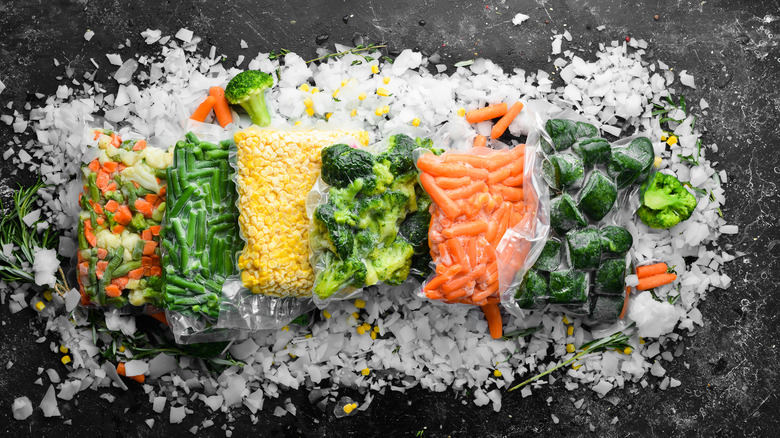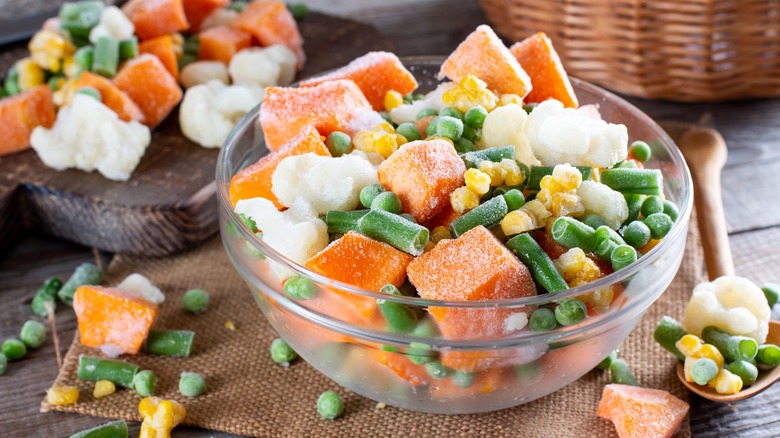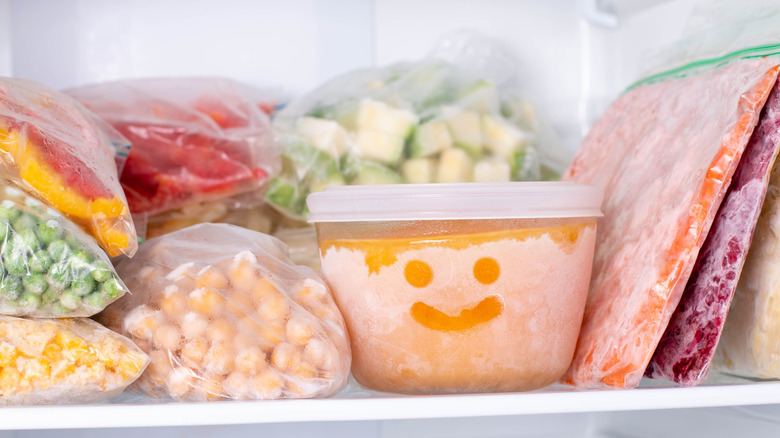Why Frozen Food Is Safe To Eat Without Added Preservatives
The modern frozen food industry has come a long way since the first time humankind began preserving food using freezing temperatures. While the convenience of buying frozen foods to be stored in your freezer at home is a fairly new phenomenon, the science behind why freezing works so well hasn't changed. To make food last for months or years, preservatives are often needed to extend its shelf life, unless the food is frozen. Low temperatures prevent the growth of harmful microbes that can spoil food and cause gastrointestinal illnesses.
From frozen vegetables to ready-to-eat meals, grocery stores today are stocked with a wide array of freezer products, and many of these may travel thousands of miles from a production plant to your local grocery store. Despite being frozen, you may think that some help from preservatives would be needed to keep these foods fresh, but many frozen foods have short ingredient lists that are free from preservatives. Consistently freezing temperatures can be all that's needed to preserve food properly. The safety and quality of these products depends on proper storage from the producer to the distributor to the consumer. It's all about keeping food consistently frozen, since bacteria will begin spreading as soon as it starts to thaw.
When it comes to frozen food, temperature matters
In contrast to of using preservatives, freezing food is a natural form of preservation that manipulates the environment around the food. Freezing may seem like a magic way of stopping time, but the science behind it is easy to understand. Most freezers are kept at or below zero degrees Fahrenheit. Because microbes will not grow in spaces kept at under zero degrees Fahrenheit, frozen food remains safe to consume for long periods of time (though the quality of its flavor and texture may decline).
Take peas, for example, which are one of the most popular frozen veggies. If left out at room temperature (about 70 degrees Fahrenheit), a bag of shelled peas would soon grow moldy and mushy, and if stored in the refrigerator (about 37 degrees Fahrenheit), they would last a few days. In the freezer, however, peas can remain edible for up to two years. They'll be certainly different from fresh peas, but will be perfectly safe to eat once cooked.
It is important to note that freezing temperatures do not kill bacteria — they merely put the germs into a kind of hibernation. You still have to cook the food to kill off any bacteria. This "hibernation" is useful because it stops bacteria from multiplying on food, as more bacteria leads to spoilage. The life of frozen food is prolonged due to this effect, but it still needs to be cooked thoroughly before enjoying.
How to safely store foods that were frozen
Once you bring frozen food home, especially products without preservatives, you still have to keep it frozen constantly — with no accidental thawing — so it remains safe to eat. There are a few cautionary steps you can take. The simplest step is to make sure you always fully close your freezer door. This may seem obvious, but if the freezer door is not properly sealed shut, warm air can enter, causing frozen food to thaw and bacteria to form over time. You should also regularly check the thermometer in the freezer to make sure it remains at zero degrees Fahrenheit.
Organization can also keep your frozen foods safe and your freezer tidy. It's a good idea to carefully load food in your freezer after cleaning it so that frozen products that are slightly more perishable are stored in the coldest parts of your freezer. Lastly, know that once foods are thawed, it's rarely a good idea to re-freeze them. The food won't necessarily be unsafe to consume, but repeatedly thawing and re-freezing foods can cause their quality to rapidly deteriorate due to moisture loss, which can even cause freezer burn. It's better to freeze foods like soups, veggies, leftovers, and more in smaller, separate portions, so you only have to remove and thaw as much as you need, keeping the rest of the food safely in the freezer.



